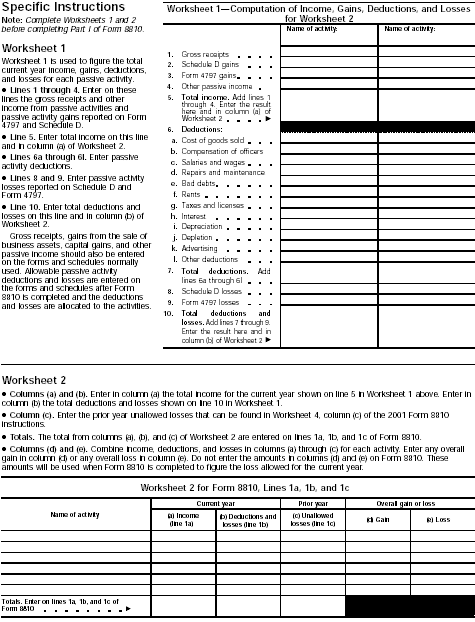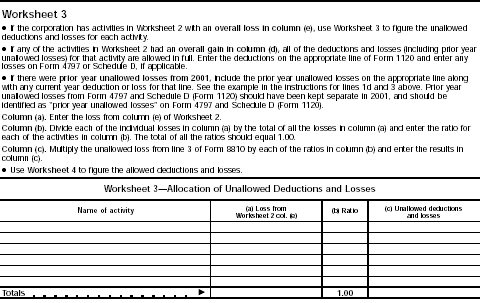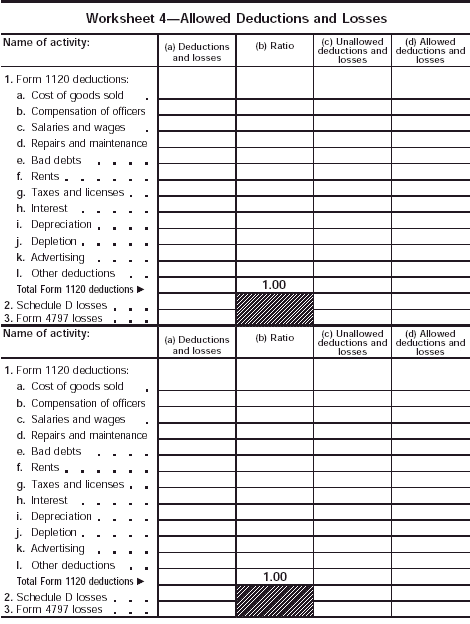Former Passive Activities
A former passive activity is any activity that was a passive activity in a prior tax year but is not a passive activity in the current tax year. A
prior year unallowed loss from a former passive activity is allowed to the extent of current year income from the activity.
If the current year net income from the activity is less than the prior year unallowed loss,
enter the prior year unallowed loss and any current year net income from the activity on Form 8810 and the applicable worksheets.
If the current year net income from the activity is more than or equal to the prior year unallowed loss from the activity,
report the income and loss on the forms and schedules normally used; do not enter the amounts on Form 8810.
If the activity has a net loss for the current year,
enter the prior year unallowed loss (but not the current year loss) on Form 8810 and the applicable worksheets.
To report a disposition of a former passive activity, follow the rules under Dispositions below.
Dispositions
Disposition of Less Than an Entire Interest
Gains and losses from the disposition of less than an entire interest in an activity are treated as part of the net income or net loss from the
activity for the current year.
Note:
A disposition of less than substantially all of an entire interest does not trigger the allowance of prior year unallowed
losses.
Disposition of an Entire Interest
If the corporation disposed of its entire interest in a passive activity or a former passive activity to an unrelated party in a fully taxable
transaction during the tax year, the losses allocable to the activity for the year are not limited by the PAL rules. A fully taxable transaction
is a transaction in which all the realized gain or loss is recognized.
If the corporation is using the installment method to report this kind of disposition, figure the loss for the current year that is not limited by
the PAL rules by multiplying the corporation's overall loss (which does not include losses allowed in prior years) by the following
fraction:
Gain recognized in
the current year |
Unrecognized gain
as of the beginning of the current year |
Unallowed passive activity credits, unlike unallowed passive activity losses, are not allowable when the corporation disposes of its interest in an
activity. However, the corporation may elect to increase the basis of the credit property by the amount of the original basis reduction of the
property to the extent that the credit has not been allowed under the passive activity rules. Unallowed passive activity credits that are not used to
increase the basis of the credit property are carried forward until they are allowed. To make the election, complete Part III of Form 8810. No basis
adjustment may be elected on a partial disposition of the corporation's interest in a passive activity.
A partner in a PTP is not treated as having disposed of an entire interest in an activity of a PTP until there is an entire disposition of the
partner's interest in the PTP.
Reporting an Entire Disposition on Schedule D or Form 4797
When the corporation completely disposes of an entire interest in a passive activity or a former passive activity, there may be net income or loss
and prior year unallowed losses from the activity. All the income, gains, deductions, and losses are reported on the forms and schedules normally
used.
Combine all income, gains, deductions, and losses (including any prior year unallowed losses) from the activity for the tax year to see if the
corporation has an overall gain or loss.
If the corporation has an overall gain from a passive activity and also has other passive activities to report on Form 8810, include the income,
gains, deductions, and losses (including prior year unallowed losses) on Worksheet 1 on page 7. If this is the corporation's only passive activity or
a former passive activity, report the income, gains, deductions, and losses (including prior year unallowed losses) on the forms and schedules
normally used, but do not enter them on the worksheets or on Form 8810.
If the corporation has an overall loss when combining all income, gains, deductions, and losses (including any prior year unallowed losses) from
the activity, report all of the income, gains, deductions, and losses on the forms and schedules normally used, but do not enter them on the
worksheets or on Form 8810.
Note:
Members of a consolidated group, see Regulations section 1.469-1(h)(6) and Temporary Regulations sections 1.469-1T(h)(7) and (8) for rules on
applying the passive loss rules to dispositions of property and other intercompany transactions.

Specific Instructions on Page 7, Worksheets 1 and 2
Part I - 2002 Passive Activity Loss (PAL)
Lines 1d and 3.
If line 1d or 3 shows net income or zero, all the deductions and losses are allowed including any prior year unallowed losses entered on
line 1c. Enter the deductions on the appropriate lines of Form 1120 and any losses from Form 4797 or Schedule D (Form 1120) on that form or schedule,
if applicable, including any prior year unallowed losses that are properly entered on those forms.
If the prior year unallowed losses include deductions that would have been reported on page 1 of Form 1120 instead of on Form 4797 or Schedule D,
include the prior year unallowed losses on the appropriate line along with any current year deduction or loss from that line.
Example.
The corporation had $1,000 of deductions for current year repairs and maintenance and $500 of deductions for prior year unallowed repairs and
maintenance. Enter $1,500 as the deduction for repairs and maintenance allowed from passive activities on the proper line.
Line 2 - Closely held corporations.
Closely held corporations can offset the loss, if any, on line 1d with net active income. Net active income is the corporation's taxable
income for the tax year, determined without regard to the following items:
- Net passive income or loss.
- Portfolio income. See Passive Activity Income on page 5.
- Deductions attributable to portfolio income described in Temporary Regulations section 1.469-2T(d)(2)(i), (ii), and (iv).
- Interest expense allocated under Temporary Regulations section 1.163-8T to a portfolio expenditure (within the meaning of Temporary
Regulations section 1.163-8T(b)(6)).
- Gain on the disposition of substantially appreciated property formerly held for investment. See Regulations section
1.469-2(c)(2)(iii)(F).
- Gross income from certain oil or gas properties treated under Regulations section 1.469-2(c)(6) as not from a passive activity.
- Gross income and deductions from any trade or business activity of trading certain personal property described in Temporary Regulations
section 1.469-1T(e)(6), but only if the corporation did not materially participate in the activity for the tax year.
If the corporation disposed of its entire interest in a passive activity to an unrelated party in a fully taxable transaction, figure
net active income by taking into account an overall loss from that activity only to the extent it exceeds overall gain from all other passive
activities (the gain, if any, shown on line 1d of Form 8810).
If there is an overall loss from all other passive activities (line 1d of Form 8810 is a loss), figure net active income by taking into account
all of the overall loss from that activity.
Line 4 - Total deductions and losses allowed.
- Worksheet 2. Columns (d) and (e) of Worksheet 2, on page 7, show whether an activity had an overall gain or loss.
- Column (d). A corporation with an overall gain in column (d) will report all of the deductions and losses listed in Worksheet 1
and any prior year unallowed losses in Worksheet 2 for those activities on the appropriate lines of Form 1120 and on Schedule D or Form 4797, if
applicable.
- Column (e). A corporation uses Worksheets 3 and 4 for activities that show an overall loss in column (e).
- Worksheet 3, below, is used to figure the unallowed deductions and losses to be carried forward to Worksheet 4, on page 9. Use
Worksheet 4 to figure the allowed deductions and losses to report on the forms and schedules for 2002.

Worksheet 3 on Page 8
Worksheet 4
Use Worksheet 4 to allocate the unallowed deductions and losses for each activity among Form 1120 deductions and any losses to be reported on Form
4797 and Schedule D.

Worksheet 4
If the unallowed loss is reported on one form or schedule, skip the following example and complete Worksheet 4.
If the unallowed loss is from losses reported on more than one form or schedule, allocate the unallowed loss from column (c) of Worksheet 3 among
the net losses as follows:
Example.
The corporation has one passive activity. The activity has an unallowed loss of $18,000 in column (c) of Worksheet 3 and the following net losses
and net gain:
| Form 1120 |
| Gross receipts |
$100,000 |
| Deductions |
120,000 |
| Net loss |
($20,000) |
| Schedule D |
|
Form 4797 |
|
| Gain |
$1,000 |
Gain |
$5,000 |
| Loss |
(2,000) |
Loss |
(2,000) |
| Net loss |
($1,000) |
Net gain |
$3,000 |
Add the net losses of $20,000 and $1,000, for a total of $21,000. Divide the net loss reported on each form by the total of the net losses, and
multiply the result by the unallowed loss of $18,000, as shown below:

Form 1120 & Schedule D
On Form 4797, report the $2,000 loss and the $5,000 gain. On Worksheet 4, enter the $17,143 of unallowed deductions allocated to Form 1120 in
column (c) on the line for total Form 1120 deductions. Enter the $857 of unallowed Schedule D losses in column (c) of line 2. Worksheet 4 is used to
allocate the $17,143 to the Form 1120 deductions and show the allowed and unallowed Schedule D loss.
Line 1, column (a).
Enter the current year deductions for each Form 1120 expense (lines 6a through 6l of Worksheet 1) plus any prior year unallowed Form 1120 deduction
for that activity. For example, if line 6i of Worksheet 1 shows current year depreciation for the activity of $2,200, and the activity had prior year
unallowed depreciation of $1,200, enter $3,400 on line 1i, column (a), of Worksheet 4.
Line 2, column (a).
Enter any Schedule D losses from line 8 of Worksheet 1 plus any prior year unallowed Schedule D losses for that activity.
Line 3, column (a).
Enter any Form 4797 losses from line 9 of Worksheet 1 plus any prior year unallowed Form 4797 losses for that activity.
Line 1, column (b).
Divide each of the individual Form 1120 deductions shown in column (a) by the total of all of the Form 1120 deductions in column (a) and enter the
ratio for each of the deductions in column (b). The total of the ratios must equal 1.00.
Column (c).
Allocate the portion of the loss in Worksheet 3, column (c), among the Form 1120 deductions by multiplying the unallowed loss attributable to the
total Form 1120 deductions by each of the ratios in column (b). Enter the portion of the unallowed loss in Worksheet 3, column (c) that is
attributable to a Schedule D or Form 4797 loss in column (c) of this worksheet.
Column (d).
Subtract column (c) from column (a) and enter the results in this column. Enter the deductions allowed for Form 1120 on the proper lines of Form
1120 and enter the allowed Schedule D and Form 4797 losses on that form or schedule.
Publicly Traded Partnerships (PTPs)
A PTP is a partnership whose interests are traded on an established securities market or are readily tradable on a secondary market (or its
substantial equivalent).
An established securities market includes any national securities exchange and any local exchange registered under the Securities Exchange Act of
1934 or exempted from registration because of the limited volume of transactions. It also includes any over-the-counter market.
A secondary market generally exists where a person stands ready to make a market in the interest. An interest is treated as readily tradable if the
interest is regularly quoted by persons, such as brokers or dealers, who are making a market in the interest.
The substantial equivalent of a secondary market exists where there is no identifiable market maker, but holders of interests have a readily
available, regular, and ongoing opportunity to sell or exchange interests through a public means of obtaining or providing information on offers to
buy, sell, or exchange interests. Similarly, the substantial equivalent of a secondary market exists where prospective buyers and sellers have the
opportunity to buy, sell, or exchange interests in a timeframe and with the regularity and continuity that the existence of a market maker would
provide.
Special Instructions for PTPs
Section 469(k) provides that the passive activity limitations must be applied separately to items from each PTP.
Losses from passive activities the corporation holds through a PTP generally can be used only to offset income or gain from passive activities of
the same PTP. Any unallowed loss from a PTP passive activity is carried forward and allowed in a tax year when the corporation has passive income from
the same PTP or when the corporation disposes of its entire interest in that PTP.
Income from passive activities the corporation holds through a PTP cannot be used to offset losses from passive activities the corporation holds
through another PTP or losses from any other passive activities.
Passive activity loss rules for partners in PTPs.
Do not include any income, gains, deductions, or losses from PTP passive activities on Form 8810. Instead, use the following rules to figure and
report income, gains, deductions, and losses from passive activities held through each PTP that the corporation owned an interest in during the tax
year:
- Combine any current year income, gains, deductions, and losses, and prior year unallowed losses to see if there is an overall gain or loss. Include
only the same types of income and losses that would be included in figuring net income or loss from a non-PTP passive activity (see Passive
Activity Income and Deductions on page 5).
- If there is an overall gain, the net gain portion (total income in excess of total deductions and losses) is nonpassive income. Report the income,
deductions, and losses on the forms and schedules normally used.
- If there is an overall loss (other than in a year in which the corporation disposed of its entire interest in the PTP), the deductions and losses
are allowed to the extent of the income, and the excess deductions and losses are carried forward for use in a future year when there is income to
offset them. Report the income and the loss allowed to the extent of income on the form or schedule normally used.
Previous| First | Next
Instructions Index | 2002 Tax Help Archives | Tax Help Archives | Home
